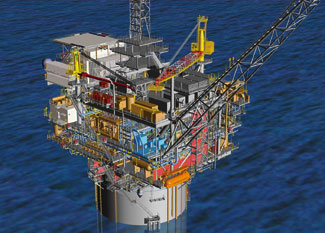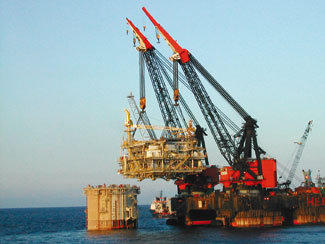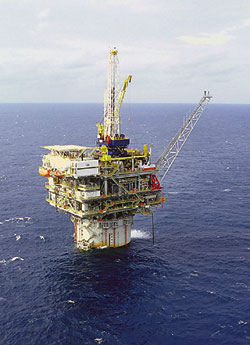| |
Vol. 227 No. 5 |
 |
Taking the fast track: Streamlining major deepwater projects
With sufficient reservoir knowledge and a previous project model, fast-tracking can work well for companies.
Daryl B. Rapp, P.E., P.M.P., Mustang Engineering L.P., Houston
There has been, and perhaps always will be, a desire on the part of deepwater field operators to accelerate production from these developments. Fast-track projects have been successfully executed in the oil and gas industry for decades. In defining fast-track, the term refers to a project that can normally be completed and yield first production ahead of a conventionally executed project of similar size and scope. Often, schedule savings will be one to two years.
Is there a way to complete major deepwater projects faster, yet with less risk? Can this method help complete more projects in the same amount of time and with the same resources allotted conventionally? This discussion about fast-tracking will answer these questions by noting advantages, disadvantages, ideal candidates and ingredients needed for executing successful projects. Ideas shared in this article are based on lessons learned from undertaking numerous fast-track projects, including four recent Gulf of Mexico deepwater developments (Fig. 1), using many techniques discussed here.
 |
Fig. 1. Typical complexity (color-coded systems) of a fast-track project.
|
|
FAST-TRACK ADVANTAGES
There are many reasons why a fast-track project makes sense. Most have to do with the economic advantages that such a project brings. The shorter schedule can generally be translated into lower costs. Streamlining the project’s decision process requires fewer man-hours of engineering time. Similarly, if construction moves ahead expeditiously as planned, it can result in lower costs and free up manpower for additional projects. Perhaps the main criterion and biggest advantage to fast-tracking is that it realizes production quicker. This realization enhances the project’s net present value (NPV), improves the cash payback and increases the value of the project’s return to company shareholders.
There could also be other scenarios that suggest the need for fast-tracking a project. In some situations inside the US or in other regions, the method might be used, where there are competing reservoirs in close proximity to a company’s field, where production needs to get online quickly. Company financial interests and reserve replacement needs could dictate early production, as could the value of capitalizing on unique market conditions. Regardless of the reasons, the fast-track project can deliver results earlier.
THERE CAN BE DISADVANTAGES
Can there be disadvantages with fast-track methodology? Absolutely. Accommodating change is one of the major disadvantages, because it works against time. The fast-track method does not allow extended studies after the conceptual or preliminary engineering stages. Similarly, process optimization of production facilities should only be undertaken early, and the earlier, the better.
Fast-tracking a project may not be compatible with a company’s standard Stage Gate process for approving capital projects. Additionally, a company’s standard procedures may need to be modified, to allow the project to proceed on a fast-track basis. The project plan should be developed, agreed upon and followed with only minimal modifications to the design basis. There are fewer opportunities to make major alterations throughout the project. If this philosophy is not adhered to, changes can lead to schedule delays and escalating project costs.
THE BEST CANDIDATE
How do we make sure a project is a good candidate for going on the fast track? First, there needs to be sufficient reservoir information about the development to proceed quickly and confidently with design and construction.
Next, there should be an atmosphere among all major stakeholders in the project – operator, partners and contractors – that allows decisions to be made quickly and definitively. Assuming that those decisions are reasonable, they should be allowed to stand without optimizing further. Empowerment and trust are keys that help unlock success for the fast-track method.
A fast-track project stands a better chance of success if it can be patterned after a “go-by,” a prior project completed with similar water depths, location and characteristics. This comparative project allows for a certain amount of standardization and repeatability to reduce risk, and shorten the entire schedule. It also can provide a basis for continual design improvements with only an incremental increase in engineering effort.
Lastly, there has to be an understanding that there will be some minor trade-offs in proceeding. Time is of the essence, pitting well-founded decisions, supported by experience, against optimization.
INGREDIENTS FOR SUCCESS
To simplify the understanding of a successful approach to fast-track success, there are four major areas that need to be addressed and understood – alignment, design basis, scope of work/ execution plan and project team experience.
Alignment. The alignment of all participants in a fast-track project is a critical element for success. All the stakeholders have to be in agreement as to the definition of the project’s goal and how it is to be reached. This alignment must be vertical within each participating organization, so that its members are synchronized, as well as among the involved companies, themselves.
There has to be an atmosphere of open and honest communication among all parties, and a relationship whereby the working level project team members are trusted and empowered by the owner to make decisions and to resolve issues as they occur. Project participants undoubtedly will have different interests, ideas and means of communicating. For a fast-track project to be effective, however, all parties must find a common ground so that the working relationship is effective.
Project goals, priorities, key philosophies and expected outcomes should be clearly articulated and defined, with agreement from all parties prior to starting work. These items may be documented by a project charter, client statement of requirements or other documents that are prepared by the client or contractor. Once agreed, the direction should be followed for the work. Strict adherence to the requirements will enable project sanction and development to be accelerated.
Design basis. As mentioned earlier, a fast-track candidate can be viable, when enough information is known about the field and its reservoir characteristics. Results of at least one exploratory or appraisal well are needed to provide a baseline for going forward. Anticipated pressures, temperatures and flowrates are important, especially as fields are found in ever-deeper waters. Determinations for water injection and gas lift, either in present or future plans, must be considered.
Flow assurance issues are extremely important, because they impact the subsea system’s design and layout. Also important is the need for consideration of critical topsides payload to accommodate production heating requirements, and liquid storage and equipment for chemical injection. Drilling rig requirements have to be determined, as do storage and operational needs. Product export assumptions must be considered, with information known about the proximity of existing export pipelines or hub facilities. If possible, export contracts should be in place before the project commences.
With a fast-track project, exact requirements, while helpful, are not mandatory to succeed. Some topsides over-design can be incorporated and, even if it adds weight, can be an acceptable trade-off for reaching first production quicker, Fig. 2. Potential challenges, however, need to be identified and understood before a fast-track project gets underway. Decisions based on the above known facts and assumptions should be incorporated in the project plan as early as possible, preferably in the concept definition phase.
 |
Fig. 2. A fast-track project being installed.
|
|
This type of project has to identify process challenges and determine the extent of existing technology issues in dealing with assumed temperatures or pressures. Can the challenges be handled with existing technologies? While adjustments for many issues can be incorporated, a fast-track project is not one where technological innovation should be proposed without a mitigation plan.
Scope of work/ execution plan. Based on the design basis above, and the client’s charter/ statement of requirements, a scope-of-work and execution plan need to be developed. Part of the execution plan is a contracting/ purchasing plan that describes how to contract or enlist contractors early in the project, to avoid delays or rework to design. Among other things, that plan needs to identify contractor and vendor selection for various provided services.
The execution plan needs to address project safety reviews and risk assessments that are necessary to ensure that project requirements are achieved. Special attention is needed to ensure that the most appropriate reviews are specified. In some cases, a Hazard and Operability (HAZOP) safety review may be replaced with a comparable technique, such as a “check list” or “what if” analysis while still maintaining safety as a top priority.
Because of the rapid progression of the fast-track project, there will be overlaps between engineering and construction. Timing of deliverables is critical and requires expeditious gathering of vendor data for engineering to create drawings and specifications for steel cutting and fabrication. Engineering and procurement schedules should be finalized after alignment and agreement is reached with the fabricator on required on-site (ROS) dates for deliverables and equipment.
Design issues can be reduced, if the installation contractors already are on the team, as early discussions can minimize misdirection of design. Therefore, contractors need to become an integral part of the project early, so that construction planning and sequencing can be efficient. Stage-Gate processes that move the project from one phase to the next can be used successfully in a fast-track project, but they may be modified from their normal application. This way, stages are shorter and less-rigidly defined than with conventional use of this technique.
Contracts for fast-track projects often use a mixed strategy for compensation, combining reimbursable, unit-rate basis and lump-sum contracts. In the initial project stages, it is often advantageous to remunerate engineering services with a reimbursable rate to assure that changes will be made expeditiously at the most reasonable cost. For fabrication, unit rates are normally preferred initially, as a contract can be placed early, based on steel tonnage estimated from comparable projects. The unit rate contracts eventually can be converted to a lump-sum basis as the project develops, and all parties become comfortable with its progress.
With a fast-track project, realistic scheduling often is based on knowledge from previous projects. Cost estimates also can be verified early in the project by benchmarking them against previous projects of similar scope. It also can be advantageous for both cost and schedule to consider a model of outsourcing skid-mounted modular fabrication, using high-quality specialty shops. This can be done while relying on the fabrication yard to handle the structural steel erection and assembly of production modules and skids.
Last, the appropriate regulatory bodies for project oversight must be identified, and submissions given to them as soon as practical. Due to the shortened timeline, there could be more regulatory risk, but it can be mitigated by early alignment with governing regulations and agency expectations.
Project team experience. Contractor experience is truly a critical factor in advancing fast-track work. If the selected project team has had prior experience with this project type, it is easier to move forward expeditiously. Cohesiveness and consistency are major advantages for this type of approach. When there is a comfort level among project participants, and an understanding of direction based on alignment with the project charter/ client scope of requirements and previous working relationships, it can add considerable value to the project.
 |
Fig. 3. Completed fast-track project in the Gulf of Mexico.
|
|
Successive fast-track projects using the same team usually can be accomplished with fewer concerns, and can continue to add value with the implementation of lessons learned from prior projects. This was the case in the project team continuity on the four recent projects. After the initial projects were completed (Fig. 3), each subsequent project was able to get underway quickly with fewer unknowns. This go-by availability and continuity reduced engineering man-hours per deliverable for each succeeding prospect.
FAST TRACK CAN BE THE ANSWER
Fast track does not equate to poor or lesser quality than a conventional construction project. Rather, a fast-track project is designed to give the client an excellent product that is fit-for-purpose. Safety and environmental considerations are not lessened, and can be the same or better than conventional projects. When addressed early, uptime, reliability and flexibility of design are all as prevalent in fast-track projects as with conventional work.
Risk is present in any project, conventional or fast-track. In a fast-track project, experienced team members help mitigate that risk with their knowledge and established procedures for execution. From a financial standpoint, risk is lessened, because of the ability to increase shareholder value through early production.
As an example, consider the improvement in net present value to shareholders when a deepwater facility, designed for 40,000 bopd, can produce at that volume for at least one year ahead of a similarly rated conventional facility. If there is the correct alignment, known field characteristics, a sound project charter with identified and agreed-upon goals, and an experienced cadre of contractors and partners, fast-track should get strong consideration for joining the race at full throttle. 
|
THE AUTHOR
|
 |
Daryl B. Rapp, P.E., P.M.P., has more than 30 years’ experience in the design and project management of oil and gas facilities. His projects have included multiple types of floating offshore facilities, as well as onshore plants. He was the project manager for four fast-track, truss spar topside facilities that have recently reached first oil in the deepwater Gulf of Mexico. Mr. Rapp is a graduate of Purdue University, a Registered Professional Engineer in the State of Texas and a Project Management Professional.
|
|
|






